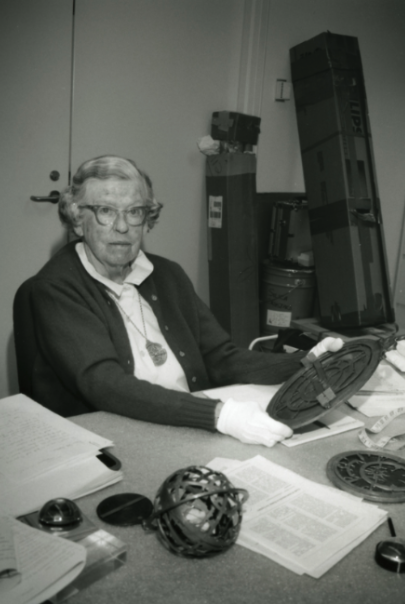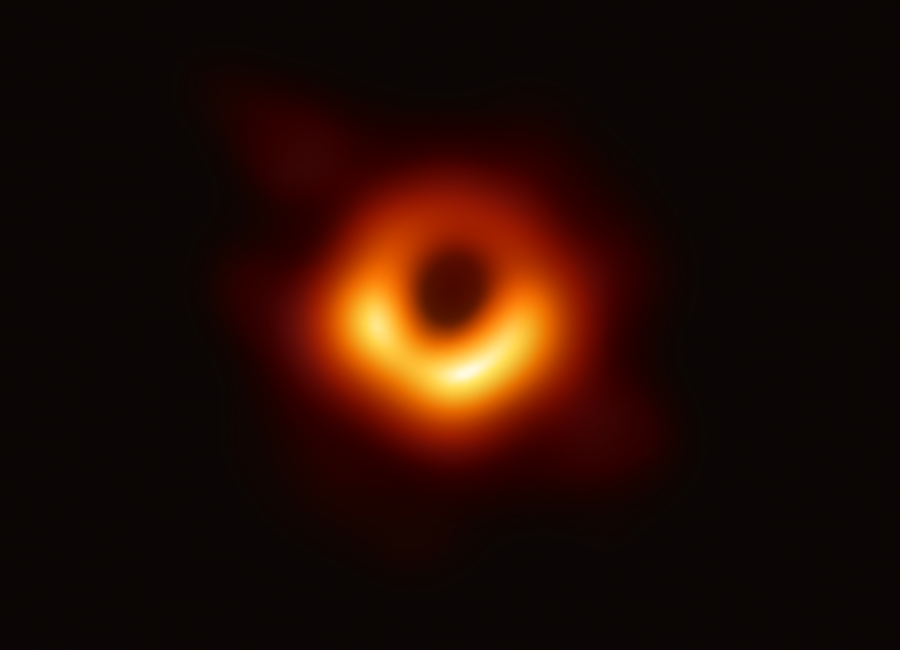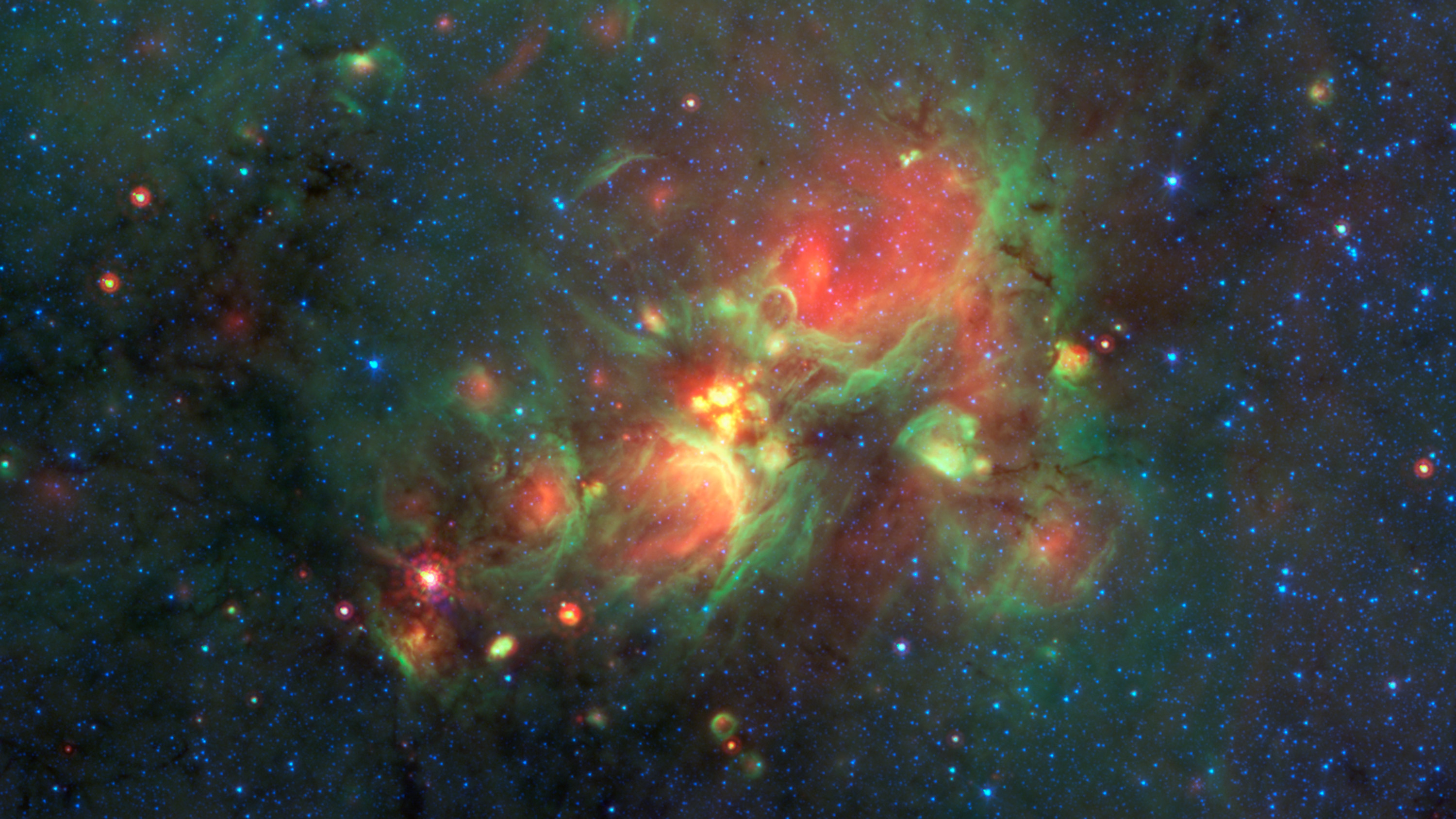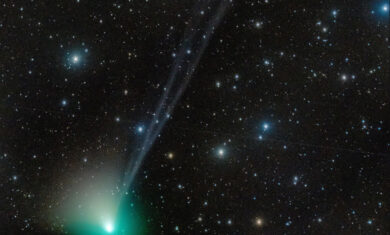A Passion for Scientific Instruments: Remembering Marjorie K. Webster

Header Image: Madge Webster in her element, surrounded by historical scientific instruments, and holding an astrolabe while wearing another one in a necklace (Adler archives).
While to many the name “Webster” will evoke a famous dictionary, in the Adler family it resonates with collections, history of astronomy, a passion for scientific instruments, and generous support to the Planetarium. This is due to the action of Marjorie K. Webster (1915-2011) and Roderick S. Webster (1915-1997), still remembered affectionately as Madge and Rod.
Marjorie Kelly Webster was born on June 9, 1915, to father Carl, an executive in the steel industry near Chicago, and mother Marjorie (née McCurdy). Madge attended North Shore Country Day School, and then Sarah Lawrence College. During her college days she spent time at Pueblo Santo Domingo in New Mexico working with Native American schoolchildren and exploring local archaeological sites. She also attended the University of California, Berkeley, and during World War II worked for the Douglas Aircraft Company, where she reached a managerial position.
In 1953, Madge married Roderick Sheldon Webster (who did have a familial connection with the famous American lexicographer Noah Webster). They had been high school friends, and together they would make a tremendous impact in the Adler and beyond. In the early 1960s, following the purchase of an antique sundial and an ensuing fact-finding trip to the British Museum in London, they were led to the Adler Planetarium where they found an already impressive collection of scientific instruments and rare books, but also a lack of staff commanding the expertise necessary to properly contextualize, preserve, and present those amazing artifacts and books to the public. They would soon volunteer to help change that picture.
Between 1962 and 1969 Madge and Rod served as volunteer caretakers, and from 1970 until retiring in 1991, they acted as volunteer co-curators. They also served on the Adler’s board and its Collections Committee. Importantly, Madge and Rod developed a wide network of scholars, curators, and rare books and antique instrument dealers, which allowed them not only to develop a solid expertise in the history of astronomy and its instruments, but also to acquire a substantial number of instruments and books for the collections, many of them very rare or one-of-a-kind items. These acquisitions were mostly made with their own funds and then generously gifted to the Planetarium.
Through their extensive exchanges with the wide array of people and institutions in the aforementioned network, and their frequent presentations in international conferences, Madge and Rod raised the status of the Adler to that of a museum hosting world-class collections. Even though they were overall self-made curators and historians of instruments, the Websters played a fundamental role in the professionalization of collections care and curation at the Adler. They also endorsed several initiatives supporting early career scholars and graduate students, effectively helping spur the field of history of science.
Remembering Madge Webster
Madge’s love for scientific instruments went beyond studying and examining them; she would even wear instruments as jewels. But it was not only Madge’s acumen as an historical instrument expert and her famously infallible memory that made her a legend at the Adler. Several other traces of Madge’s personality left an enduring mark at the Adler and its personnel, as attested by the recollections shared below by two long-serving Adler staff members. And Madge’s legacy lives on in every exhibit, program, or project involving the Adler’s collections, which she would have been pleased to see today occupying such a prominent place in the Planetarium and its offerings.
“Mrs. Webster was well known and respected as an expert in the field of antique instruments. But along with her expertise, I remember her as being very generous, down-to-earth, and kind. One of my prized possessions is a copy of the first book of the Adler’s Historic Scientific Instruments series, Western Astrolabes, by Roderick and Marjorie Webster. I timidly requested an autograph for my copy, and Mrs. Webster obliged: “To Karen from Madge with affection – 8-11-98.” Receiving such a warm, personal inscription from such a great lady was beyond my expectations and is a reminder of her awesomeness.” – Karen Donnelly, Executive Assistant, Adler Planetarium
“I was always in awe of Mrs. Webster. I could never bring myself to call her anything but Mrs. Webster. She commanded a room, but, once, I got to see her playful side. On the Adler’s 1999 total solar eclipse cruise in the Black Sea, Mrs. Webster and a friend of hers insisted on wearing the same Adler logo temporary tattoos that we were using with the kids on the ship. Where did Mrs. Webster’s friend want her tattoo placed? On her cheek. Where did Mrs. Webster want her tattoo placed? In the middle of her forehead. She was funny and sharp…and she was amazing.”– Michelle Nichols, Director of Public Observing, Adler Planetarium







